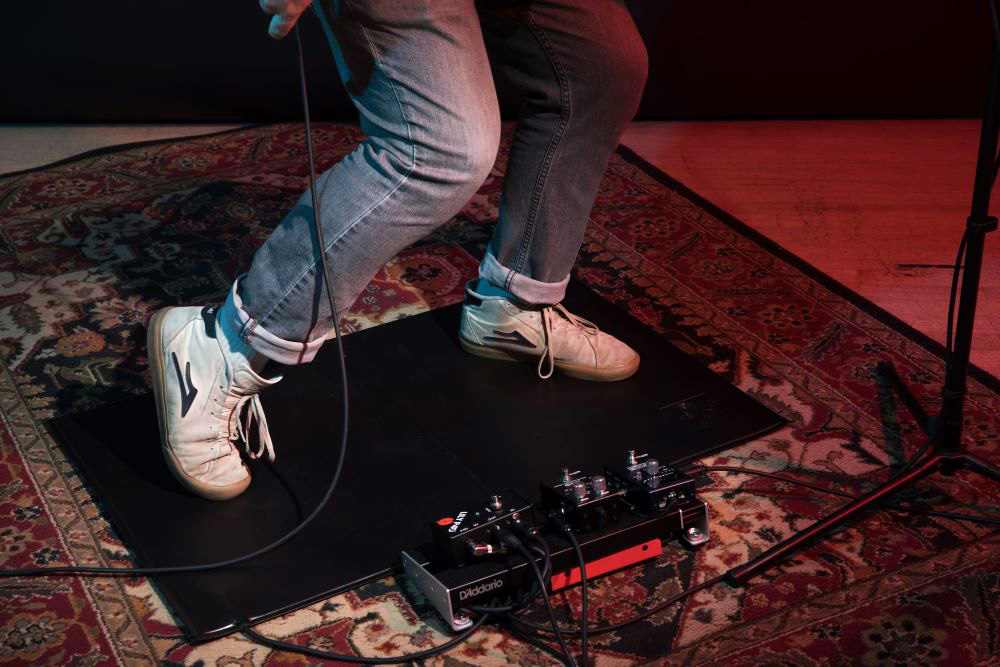The new Lily P4D aims to neutralize one of the most persistent live performance gremlins: microphone bleed. No matter how carefully artists choose their mics nor how attentively an engineer rides faders, some amount of undesired sound energy from nearby sources is bound to seep into mics meant for vocals, horns, or other instruments. The louder the band and the smaller the stage, the more the bleed, muddying the mix and elevating feedback anxiety.
Developed by musician and veteran event A/V provider Drew Becker, the Lily P4D (Pad for Ducking) takes on this problem with an approach that is so effective precisely because it is such a simple analog design.
Under Pressure
The heart of the Lily P4D is a pressure-sensitive pad, available in two sizes. The Travel Pad is a 10 x 15-inch two-fold design that keeps packing light for artists on the go. The pad is black on one side and tan on the other, and may be used either side up.

The Arena Pad is black on both sides, resembles a general-purpose ergonomic mat, and measures 24 x 36 inches while folding down to 18 x 24 inches. Either pad sits on the stage floor near the microphone it controls.

Operation is simple: When the artist’s foot is on the pad, the system passes mic-level signal with no change in gain, frequency, or phase. When the pad does not sense pressure, gain reduction is applied.
How It Works
Either pressure pad connects to the control pedal via a six-foot, 1/4-inch TRS cable that is non-detachable on the pad end. The pedal provides an XLR mic input and XLR out for the P.A. and can be powered from the included 9-volt DC adapter or a pedalboard power system, so long as a minimum of 150 mA is available to the Lily P4D. The connector is 2.1 mm, center-negative.
A recessed toggle selects between high, medium, and low tiers of gain reduction. Atop the unit is a stompbox-style bypass switch. Why bypass? During sound check, it is useful for all mics to be open all the way so that the engineer can set basic levels and “ring out” problem frequencies using EQ.

With the Lily P4D active, a status LED glows pink when the pad is not pressed (no gain reduction) and white when it is. In bypass mode, those colors switch to red and yellow, respectively.
The Lily P4D can be used with dynamic or condenser mics as it passes 48-volt phantom power (though it does not provide it) but is not intended for use with ribbon mics.
How Low Does It Go?
Two factors determine the amount of gain reduction applied: the position of the gain switch and the make, model, and impedance of the microphone used. The downloadable user manual includes a chart showing the gain reduction as tested with many popular mics from AKG, Audio-Technica, Audix, Earthworks, DPA, Electro-Voice, Heil, Neumann, Sennheiser, Shure, and others.
For example, the Lily P4D reduces a Shure SM58 by 20, 28, and 40 dB at low, medium, and high settings. According to the manual, Lily P4D’s customer support is happy to provide specs for any mic not currently on the list.
In Use
The pad is sensitive enough that the artist does not need to think about how much pressure they are applying, but durable enough to survive the stiletto heels some lead singers wear. It’s also thin enough not to be disruptive and tends not to creep around the stage — though it can be secured with gaffer’s tape for more stability — making it easy to integrate into performance movement onstage.

Stepping on the pad when one is about to sing or play quickly becomes intuitive and requires no awkward looking at the floor. When an artist is on the mic, they’re on the pad.
Sonically, Lily P4D offers numerous advantages over a gate, which is the technology traditionally used to tame mic bleed. Since a gate functions like a compressor in reverse — i.e., the presence of signal opens it — that signal must get to the gate first. However quick the gate is, there is bound to be a bit of latency or pumping effect as it opens. With the Lily P4D, the “gate” is entirely under the artist’s control and opens just before the artist generates signal.
Early Reflections
Artists who have gig-tested the Lily P4D include Umphrey’s McGee, moe., and Brantley Gilbert. “Some front-of-house engineers struggle with excessive stage volume, such as loud guitars and drums that can smear the tonality of the vocal mics,” observes Umphrey’s front of house engineer Chris Mitchell. “The Lily P4D solves that issue. It’s effortless, tough, and small, and just works.” Brantley Gilbert guitarist Spencer Wassdorp adds: “If you’re using any sort of optogate or switches for your mics, go ahead and sell them.”
Go here to learn more about the new Lily P4D.




















